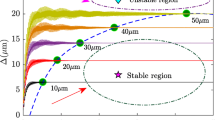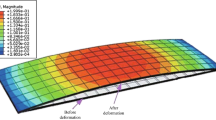Abstract
At W.T.C.M., in cooperation with the Catholic University in Leuven, Belgium, a lot of studies have been performed on the subject of residual stresses in grinding [1]. Till now, the research has been limited to the measurements of residual stresses. These measurements are rather complex and timeconsuming. This is one of the reasons why a method has been developed to calculate residual stresses. This gives the opportunity to predict these stresses, on the basis of the grinding conditions set on the grinding machine.
Access this chapter
Tax calculation will be finalised at checkout
Purchases are for personal use only
Preview
Unable to display preview. Download preview PDF.
Similar content being viewed by others
References
Peters J. and Vansevenant E., The influence of grinding parameters and wheel characteristics on residual stresses in surface grinding. JahrbuchSchleifen, Honen, Läppen und Polieren, 52. Ausgabe, Vulkan Verlag, Essen, p.20–34.
Maris M., Thermiscaspectenvandepppervlakte integriteit bij het slijpen, Dissertation K.U. Leuven, 1977.
Vansevenant E., A Subsurface Integrity Model in Grinding, Dissertation K.U.Leuven, 1987.
Lee D., Anexperimenstudyofthermalaspectsof grinding, Dissertation Univ. of Cincinnati, 1971.
Verkerk J., Wheelwe a rcontrol in grinding, Dissertation T.H. Delft, 1976.
Malkin S., The attritious and fracture wear of grinding wheels, Dissertation Mass. Inst, of Technology, 1968.
Carslaw H. and Jaeger J., Conduction ofheatinsolids, Oxford at the Calendron Press, Second Edition, London, 1967.
Des Ruisseaux N., Thermalaspectsofgrindingprocesses, Dissertation Univ. of Cincinnati, 1968.
Boley B. and Weiner J., Theoryofthermalstresses, John Wiley & Sons Inc., New York-London-Sidney, 1966.
Avrami M., Kinetics of Phase Change II, Transformation Time Relations for Random Distribution of Nuclei. Journal of Chemical Physics, Vol. 8, p. 212-224.
Koistinen D., Marburger R., A General Equation Prescribing the Extent of the Austenite-Martensite Transformat in Pure Iron-Carbon AlloysandPlainCarbon Steels, Acta Metallurgica, 7, 1959, p. 59–60.
Author information
Authors and Affiliations
Editor information
Editors and Affiliations
Rights and permissions
Copyright information
© 1989 Elsevier Science Publishers Ltd
About this chapter
Cite this chapter
Vansevenant, E. (1989). Prediction of Residual Stresses in Grinding Operations on the Basis of Mathematical Models. In: Beck, G., Denis, S., Simon, A. (eds) International Conference on Residual Stresses. Springer, Dordrecht. https://doi.org/10.1007/978-94-009-1143-7_77
Download citation
DOI: https://doi.org/10.1007/978-94-009-1143-7_77
Publisher Name: Springer, Dordrecht
Print ISBN: 978-94-010-7007-2
Online ISBN: 978-94-009-1143-7
eBook Packages: Springer Book Archive




